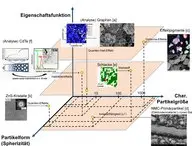Highly specific particle systems form the basis for high-quality industrial products. Particulate intermediate products with defined multi-dimensional particle technology specifications are essential and quality-determining for the production of ceramic and powder metallurgical components, coatings, printed products, porous functional structures (e.g. membranes), particle-reinforced plastics, electrodes in electrochemical energy storage systems or electronic assemblies, e.g. in the field of printed electronics. After particle production via synthesis or comminution, the particle systems used undergo a number of process steps to adjust their quality. These steps include, in particular, fractionation, i.e. the selective separation of the particle system according to particle characteristics. Comparable processes are also used in processing technology to extract special particles containing valuable materials from natural or secondary raw materials.

As the characteristic lengths of both the technical structures and the primary and secondary raw materials are continuously decreasing, ever finer, highly specific particle systems will have to be processed or produced in the future. The technology required for this is reaching its limits if industrially relevant volume flows of fine (< 10 µm) and highly specific particle systems are to be provided, as the physical separation principles used to date lose their effectiveness and selectivity in this size range. In the nanoparticle range, some special concepts for selective separation according to individual particle characteristics are currently available on an analytical scale. However, they are not yet sufficiently developed to produce technically relevant quantities. Especially in the nanometer range, where many particle properties become extremely size-dependent, completely new separation processes are required.
The established fractionation processes can only address specific and partially coupled separation characteristics. This means that separation is performed according to a characteristic that only indirectly correlates with the desired particle property. Therefore, for example, the separation of platelet-shaped particles (graphene) of a certain thickness from a size- and shape-distributed mixture (with broken graphite) is associated with a very high effort and a low yield.
The aim of the SPP is to develop a new class of fractionation processes for highly specific and multidimensional particle properties in the size range < 10 µm up to a TRL 4-5 by specifically inducing separation characteristics in the particle systems from the outside, implementing the processes with extreme operating parameters, increasing the throughput of analytical methods by orders of magnitude and introducing new physical, chemical and thermodynamic separation principles.
Examples of particle systems with special property functions that are only made possible by multidimensional particle properties ([a] SEM: Wikipedia, Color-coded Raman measurement for the detection of multilayer graphene platelets [1]; [b] FAU Erlangen; [c] from [2]; [d, e] TU Freiberg; [f] from [3]); [a, f] show initial possibilities for the characterization of multidimensional particle properties.
You are leaving the official website of Trier University of Applied Sciences